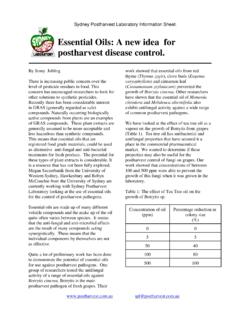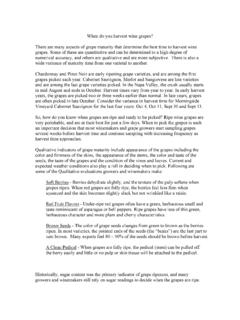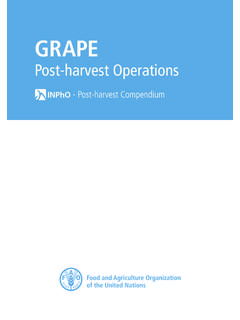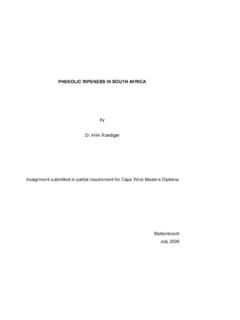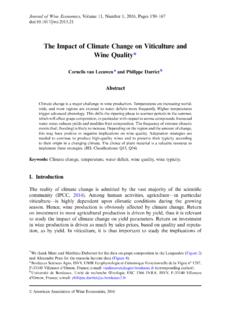Transcription of Postharvest Ethylene: A critical factor in quality …
1 Sydney Postharvest Laboratory Information Ethylene: A critical factor in quality Jenny JoblingEthylene plays a role in the postharvestlife of many horticultural is a colourless gas with a faintsweetish smell that is the naturallyproduced ripening hormone of somefruit. It is also produced as an exhaustgas from petrol combustion article will outline some of thebeneficial and negative effects ofethylene on the quality of fresh important role of ethylene as a plantgrowth regulator has only beenestablished over the last 50 years but itseffects have been known for (1992) gives the example of howthe flammable gas used for lightingstreet lamps in Europe contained addedethylene so the lamps burnt with ayellow flame. It was observed thatplants growing near any leaky pipesshowed some strange growth patternssuch as premature leaf fall and death oftheir flowers.
2 Observations like thosespurred the research that continues todayto determine the effects of ethylene onplant growth and are two classes of fresh produce interms of ethylene production. There areclimacteric products, mainly fruit thatproduce a burst of ethylene as they ripen,as well an increase in respiration andthere are the non-climacteric productsthat do not increase ethylene productionwhen they ripen. The more obvious wayof establishing which class a product fitsin to is whether or not the product ripensafter harvest. Products that ripen afterharvest are classed as climacteric andthey typically ripen by softeningsignificantly, by changing colour andbecome sweeter, examples are bananasand nectarines. Non-climacteric fruits donot change significantly after will soften a little, lose greencolour and develop rots as they becomeold but they do not change to improvetheir eating characteristics.
3 Non-climacteric crops include leafyvegetables, strawberries and 1: Examples of climacteric and non-climacteric (Ethylene producing)Non-climacteric(Non ethylene producing)Apples, pears, quinceCherry, blackberry, strawberryApricot, nectarine, peachEggplant, cucumber, pepperMango, avocado, bananaLemon, orange, mandarinTomato, sapodillaWater melon, honey dew melonRock melon, passionfruitGrape, lychee, loquat* From Kader (1992). Postharvest Technology of Horticultural Crops. Postharvest Laboratory Information Postharvest ApplicationsTable 2: ripening conditions for some fruit using (oC)Ethylene (ppm)Treatment time (hrs)Avocado18 - 211024 - 72 Banana15 - 211024 Kiwifruit18 - 211024 Persimmon18 - 211024 Tomato13 - 2210 Continuous*From Wills et al.
4 (1998). Postharvest . 4th Edition. P. most commonly know use ofethylene is to trigger ripening is somecrops, such as bananas and application of ethylene at acontrolled rate means that these productscan be presented to the customer as ready to eat . For avocados this is asignificant benefit as the consumer cannow purchase an avocado to eat thatnight rather than buying a hard fruit thatmay take several days to concentration of ethylene requiredfor the ripening of different productsvaries. The concentration applied iswithin the range of 1 and 100 ppm. Thetime and temperature of treatment alsoinfluences the rate of ripening with fruitbeing ripened at temperatures between15 to 21 oC and relative humidity of 85 90 %.Although controlled ripening is themajor Postharvest use of ethylene it canalso be applied pre-harvest to promotepostharvest benefits.
5 The chemicalEthephon produces ethylene and isapplied in the field. Ethephon canpromote several benefits such as fruitthinning (apples, cherries), fruitloosening prior to harvest (nuts), colourdevelopment (apples), degreening(citrus), flower induction (pineapples)and it can stimulate lateral branching inpotted plants (azaleas and geraniums).All these responses are the result of theplant being exposed to fairly lowconcentrations of the plant growthregulator EffectThe presence of ethylene is not alwaysbeneficial, especially in terms ofpostharvest shelf life (Optimal Fresh,2000). It seems that because it is acolourless gas that is not often measuredin commercial situations its presence isover looked. A recent survey thatincluded the wholesale markets,distribution centres and retail storesaround Sydney showed that theconcentration of ethylene present duringthe marketing of fresh produce wasbetween and ppm.
6 The mainsources of ethylene during marketingand retail sale are from other ripeningfruit in the market or storage room orfrom the exhaust gases of vehicles andforklift trucks. The levels reported hadthe potential to cause a 10 30% loss inshelf life of fresh produce (Wills et al.,2000). The effect of ethylene isaccumulative so continuous exposure toa low concentration of ethylenethroughout marketing can causesignificant harm (Wills et al., 2000).Sydney Postharvest Laboratory Information the loss of shelf life will bemost frustrating for the final consumeras the loss of quality will not be obviousduring marketing and retail major reason for the loss of shelflife is that ethylene exposure increasesthe rate the product ages. In green tissuesuch leafy vegetables and cucumbersethylene stimulates the loss ofchlorophyll or green colour and alsoincreases the susceptibility of theproduct to rots.
7 For maximum shelf lifeand quality green leafy vegetablesshould not be stored or transported intrucks where there are mixed loadscontaining ripening fruit such as apples,pears, mangoes, tomatoes or bananas(Optimal Fresh, 2001).Lettuce is also susceptible to ethylene. Itsuffers from a distinctive disorder, calledrusset spotting as a result of exposure toethylene. The symptoms of russetspotting are dark brown spotting of themid-ribs of lettuce leaves. The qualityof carrots can also be reduced as a resultof ethylene exposure. In response toethylene, carrots produce bitter tastingcompounds called isocoumarins. It hasbeen shown that concentrations ofethylene as low as ppm can causebitterness in carrots within 2 weeks ofstorage (Reid, 1992).
8 Ethylene can alsopromote sprouting of potatoes andtoughening of very obvious effect of ethylene is theloss of flowers or leaves from sensitiveornamental plants. Some commonflowers that are ethylene sensitiveinclude carnations, delphiniums, freesia,gypsophila and Geraldton plants should be treated withan ethylene inhibitor, such as silverthiosulfate or EthylBloc to preventflower drop resulting from ethyleneexposure and great care should be takento avoid storage with ethylene the Damaging EffectsPreventing ethylene buildup around theproduct is often the simplest method ofreducing the damaging effects ofethylene. For example products that aresensitive to ethylene are better handledwith electric forklifts rather then gaspowered ones.
9 Trucks and forkliftsshould not be left idling in enclosedspaces or during loading or unloading ofproducts. It is also important to removeover ripe or rotting fruit from the storageand handling area, as they are alsosources of ethylene. For ethylenesensitive products it is important toavoid storing them with products thatproduce high levels of ethylene (OptimalFresh, 2001). Increasing the ventilationrate of the storage area, assuming thatthe outside air is ethylene free is anotherway of reducing the level of ethylenearound fresh can also be removed by using anumber of chemical processes. Thetraditional method had been to usepotassium permanganate or permanganate reacts withethylene to produce carbon dioxide andwater. In order to scrub the airefficiently it is best to spread thepotassium permanganate over as larger asurface area as possible either in trays orwithin highly permeable cut flowers it is possible to pulse thestems with a solution of silverthiosulfate.
10 The flowers take thesolution up through their stems and thisprotects them from the effects ofethylene. There is another relativelySydney Postharvest Laboratory Information compound called EthylBloc thatis distributed in Australia by Rohm andHass. EthylBloc is a gaseouscompound that inhibits the effects ofethylene. It is effective at very lowconcentrations, as low as 10 parts perbillion (ppb). The active ingredient is 1-MCP (1-methylcyclopropene). Recentlythere was an article in Good fruit andVegetables (10:12), May 2000 reportingthe potential benefit of using 1-MCP onbananas to prevent premature can be used for treatment offlowers but is currently not registered foruse on food crops, however registrationis in is a very important planthormone and it plays a significant role inthe Postharvest life of fresh being positive andsometimes not.



